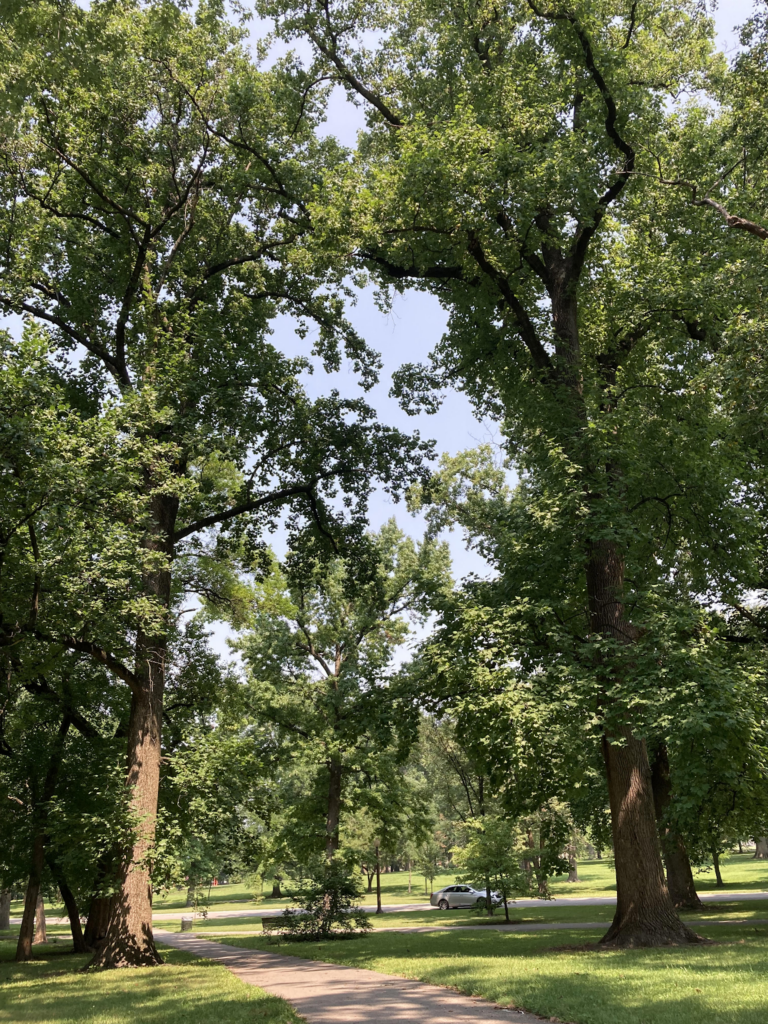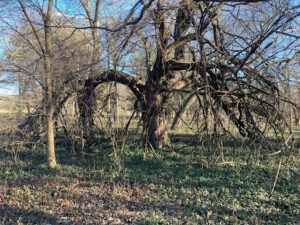By: Mark Halpin, Forestry Manager
Tulip Tree (Liriodendron tulipifera) is a poster child for the importance of scientific names. In addition to tulip tree it is known as tulip poplar, yellow poplar, tulip wood, poplar, whitewood, fiddletree and canoe wood. The ‘tulip’ family of common names refer to its yellow spring flowers’ resemblance to tulips. The other names come from the days when trees were named chiefly for their uses and lumber characteristics – tulip tree produces a light, straight-grained and soft wood that resembles poplar (Populus spp.). It is the tallest hardwood in North America – up to 200 feet, although trees of that size are rarely seen in the modern age outside of the rich ‘coves’ of the Appalachians. (The difference between a cove and a hollow, or ‘holler’ is unclear in Appalachian dialect but both are small valleys between ridges where the soil is deep and moist.)
It reaches 90-120’ more commonly, and does so quickly (Dirr lists it at 15-20’ in 6-8 years). Forest-grown specimens, and even most open-grown trees, grow very straight central leaders with little need for pruning, making it ideal for lumber production and for making dugout canoes, hence ‘canoewood’ (Daniel Boone is said to have made a 60’ tulip tree canoe, from which I’m sure he caught some improbably large fish). While this habit of thrusting extraordinarily tall and soft wood high into the heavens certainly makes it susceptible to storm damage, it doesn’t seem to happen as often as one would think. The branches tend to form good attachments to the main stem, and they also tend to be evenly spaced without significant spread (a 90’ tree is likely to be less than 50’ wide). What tends to break out are smaller branch tips that do little damage, although when large failures happen, they are large.
Because of this, it’s probably not the best choice for a residential yard, but for parks, campuses, and other open areas this is a wonderful species. Mixed in with slower growers like oaks, it will provide benefits almost immediately while the oaks take their time, creating a diverse planting that provides consistent and sustained benefits over many decades. While urban tulip trees tend to live less than 100 years, 500 year old specimens have been recorded in the wild, and there’s no reason why well-sited and cared for park trees shouldn’t last for 200 years or more. (A ‘miniature’ cultivar called ‘Emerald City’ is available, topping out at 50-60’ but with the same fast growth rate, making it one of the finest ‘nativars’ for use in urban and suburban areas. Without the size liability of the straight species it comes as close to being a “perfect tree” as any.)
Beyond its large size, it’s a relatively problem-free plant. Like all members of the Magnolia family it is susceptible to scale insects, but grows so fast it tends to outrun their populations. Tulip tree aphids (Illinoia liriodendri) seldom cause much damage, although the honeydew they produce can cause a mess on the leaves and on cars parked underneath the trees. This sugary substance can also breed black sooty mold – but these are mainly aesthetic issues. (Honeydew is easily removed with rubbing alcohol – don’t bother with soap.). It can be susceptible to ‘southwest disease’ or sunscald owing to its thin bark – resist the urge to remove the lower branches! They’ll help with this, as well as help the tree build a nice, thick trunk. Adequate moisture in the tree’s early years is quite important and this species shouldn’t be placed in highly exposed, dry areas. Drought-stricken trees’ leaves often turn yellow and may drop prematurely, but overall health is usually fine. All in all a fine, elegant tree – planted far and wide throughout North America and Europe for good reason.




